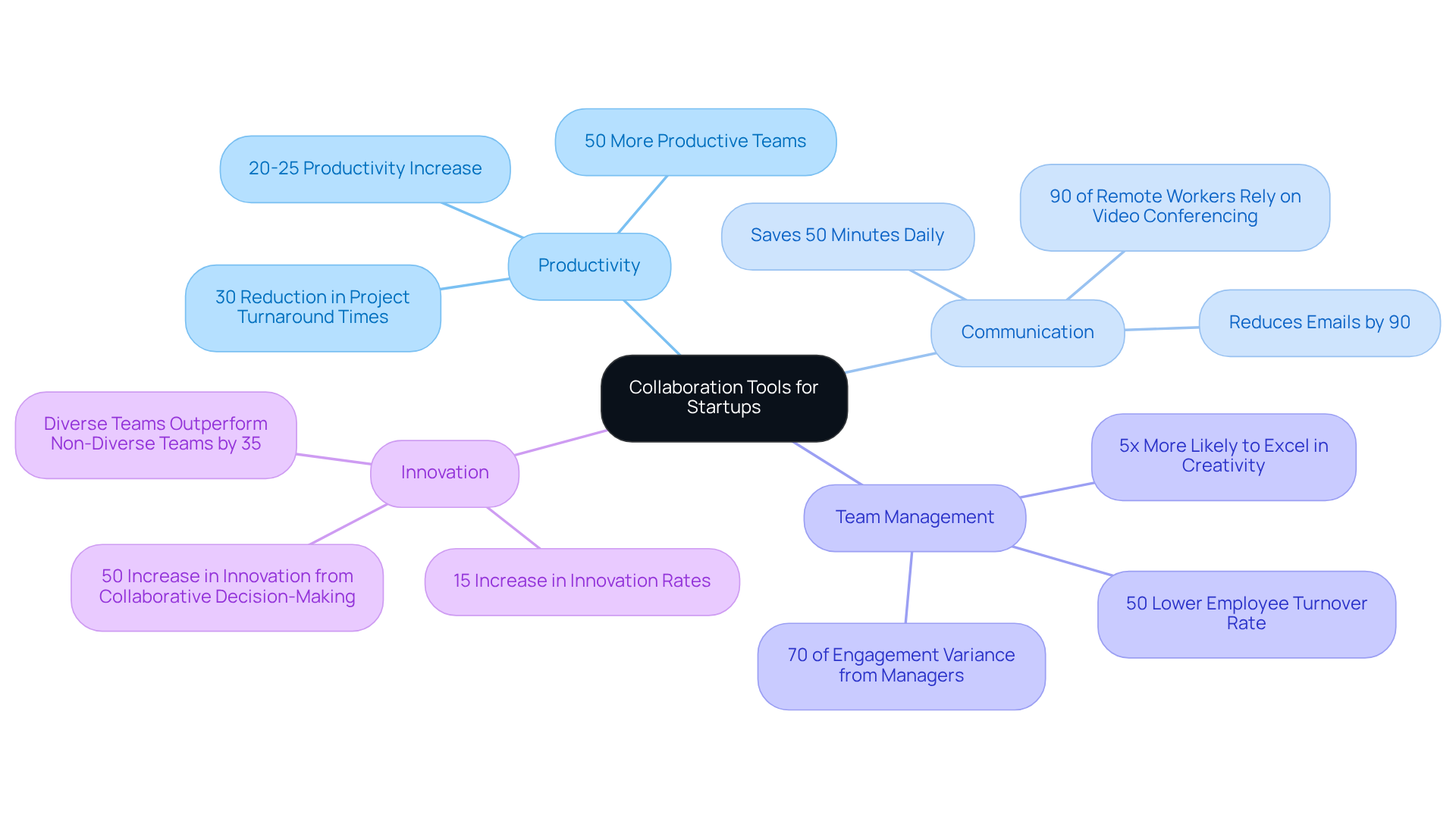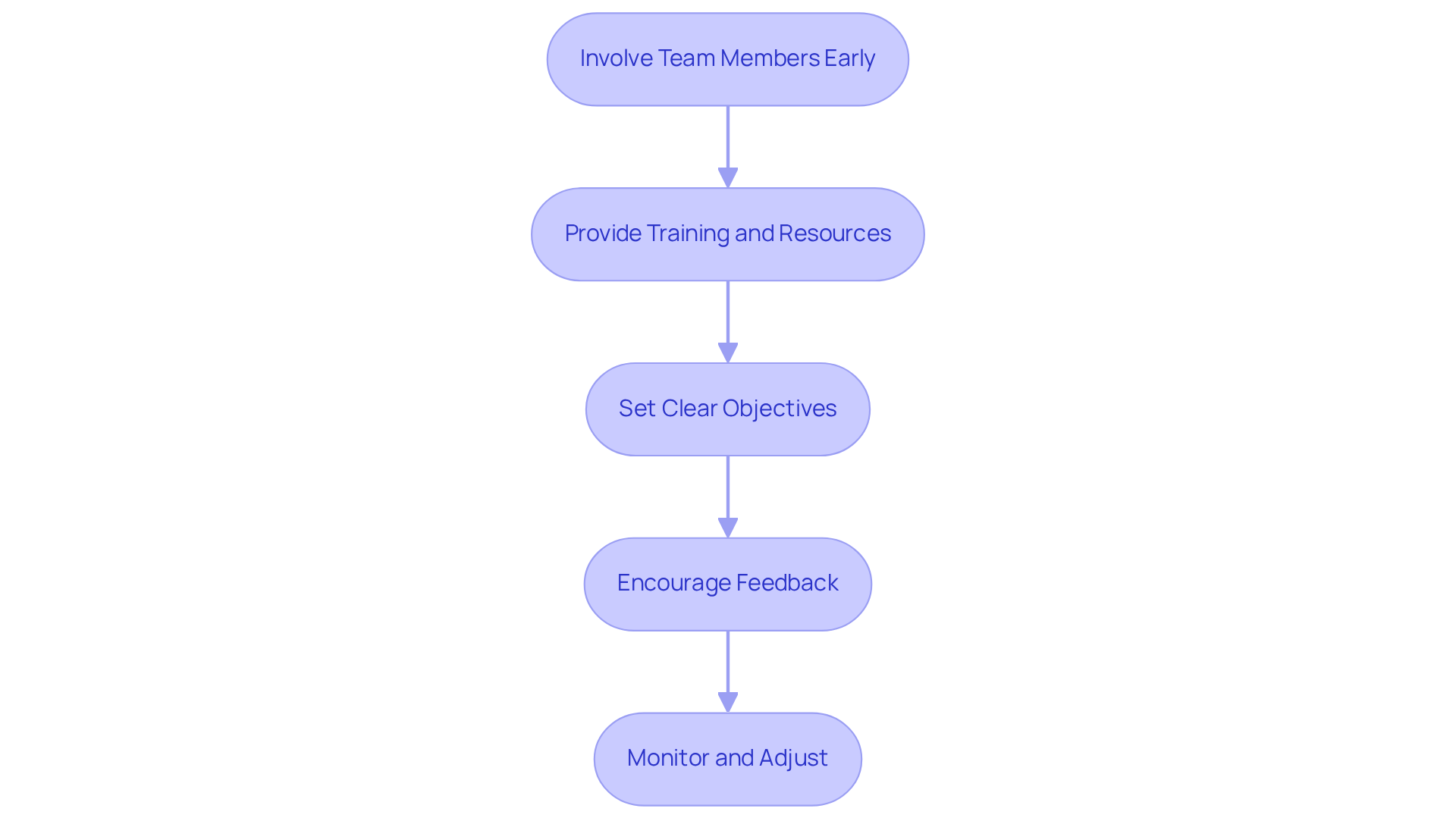Overview
The article centers on three pivotal practices for selecting the ideal collaboration tool, underscoring the significance of choosing features that enhance usability, integration, and security. It elaborates on essential attributes such as:
- Automation
- User-friendly interfaces
- The critical role of involving team members in the selection process
Together, these elements not only boost productivity but also ensure effective implementation within startups.
Introduction
In an era where collaboration can be the defining factor for a startup's success, selecting the right tools is paramount. Studies show that connected employees can boost productivity by as much as 25%, placing immense pressure on new ventures as they navigate the complexities of modern teamwork. Yet, choosing a collaboration tool goes beyond simply opting for the latest software; it requires a deep understanding of essential features, effective implementation strategies, and the unique needs of the team. How can startups ensure they select a tool that not only enhances efficiency but also nurtures innovation and teamwork?
Understand the Importance of Collaboration Tools for Startups
A collaboration tool is essential for new ventures, as it facilitates seamless interaction and coordination among group members. In today's dynamic environment, where agility is paramount, a collaboration tool helps teams stay aligned on objectives and tasks. Consider this: a study by McKinsey reveals that productivity can increase by 20-25% in organizations with connected employees. Moreover, effective communication can save employees an average of 50 minutes each day. By leveraging a collaboration tool like Casy, which automates task creation and updates, startups can ensure that all members are synchronized, reducing the risk of miscommunication and enhancing overall efficiency.
Furthermore, these resources act as a crucial collaboration tool for efficiently managing remote teams, a trend that is increasingly prevalent in the modern workplace. Startups that prioritize using a collaboration tool are better positioned to innovate and swiftly respond to market changes. According to Deloitte, cooperative teams are five times more likely to excel in creativity and innovation. Are you ready to harness the power of collaboration to drive your startup's success?

Identify Key Features of Effective Collaboration Tools
Startups must prioritize features that enhance usability and efficiency when selecting a collaboration tool. Consider the following essential attributes:
- Automation: Tools like Casy streamline workflows by automating task creation and updates. This significantly reduces administrative overhead, enabling teams to focus on their primary activities and boosting overall productivity.
- Integration: Seamless integration with existing platforms such as Slack and Telegram is crucial. Casy captures key information from conversations to automatically create tasks and set deadlines, minimizing manual input and enhancing data accuracy, which fosters a cohesive workflow.
- User-Friendly Interface: An intuitive interface promotes group adoption and reduces the learning curve, which is vital for rapidly evolving businesses. Casy requires minimal setup and manual input, making it particularly suitable for teams that need to hit the ground running.
- Protection: Given the sensitive nature of new business information, robust security protocols are essential. Casy ensures data privacy with end-to-end encryption and strict visibility controls, safeguarding user content and maintaining confidentiality.
By concentrating on these essential characteristics, startups can select a collaboration tool that not only meets their immediate needs but also promotes growth and scalability. Are you ready to elevate your collaboration efforts with tools like Casy?

Follow Best Practices for Implementing Collaboration Tools
Implementing a collaboration tool effectively necessitates a strategic approach. To maximize the potential of these tools, consider the following best practices:
- Involve Team Members Early: Engage team members in the selection and implementation process. This not only ensures the tool aligns with their needs and preferences but also fosters buy-in, significantly impacting adoption rates. As David Coleman notes, allowing IT to solely control the selection process can lead to missed opportunities for better alignment with user needs.
- Provide training and resources: Offer comprehensive training sessions and materials to assist team members in effectively utilizing the collaboration tool. This can include tutorials, FAQs, and ongoing support, ensuring that everyone feels confident in using the new system. Research shows that organizations providing sufficient training experience elevated engagement levels, with engaged groups reporting 81% lower absenteeism and 43% lower turnover.
- Set clear objectives: Define what success looks like when using the collaboration tool. Establish clear goals and metrics to assess its impact on productivity and collaboration, enabling teams to monitor progress and make informed adjustments. This clarity helps teams remain focused and aligned with organizational objectives.
- Encourage feedback: Establish a collaboration tool that allows team members to share their experiences and suggestions for improvement. This not only enhances the tool's usage but also addresses challenges swiftly, promoting a culture of ongoing improvement. Angela Ashenden emphasizes that understanding specific use cases and objectives is crucial for selecting the most appropriate collaboration resources.
- Monitor and adjust: Regularly evaluate the collaboration tool's performance and its impact on team dynamics. Be open to making changes or exploring additional functionalities that could enhance its efficiency, ensuring the resource adapts to the team's evolving needs. For instance, Angela Culver's experience with utilizing current resources within her organization illustrates the benefits of adjusting tools to meet changing team requirements.
By adhering to these best practices, startups can facilitate a smooth transition to new collaboration tools, thereby maximizing their potential to enhance productivity and streamline workflows.

Conclusion
Choosing the right collaboration tool is a pivotal decision for startups aiming to optimize productivity and enhance team dynamics. The integration of effective collaboration tools significantly streamlines communication, fosters innovation, and ensures alignment with objectives. Understanding the importance of these tools allows startups to leverage them for a more connected and efficient work environment.
This article highlights three key practices for selecting and implementing collaboration tools:
- Identifying essential features such as automation and integration.
- Adhering to best practices for implementation.
- Engaging team members early in the selection process, providing thorough training, and encouraging ongoing feedback.
Automation alleviates administrative burdens, while user-friendly interfaces and robust security measures are crucial for usability and data protection.
Ultimately, the significance of collaboration tools in driving startup success cannot be overstated. By prioritizing the right features and following best practices, startups enhance operational efficiency and foster a culture of innovation and teamwork. Embracing these tools is not merely a choice; it is a strategic move that propels a startup towards achieving its goals and adapting swiftly to market changes.
Frequently Asked Questions
What is a collaboration tool and why is it important for startups?
A collaboration tool is a resource that facilitates seamless interaction and coordination among team members. It is important for startups as it helps teams stay aligned on objectives and tasks, enhancing overall efficiency.
How can collaboration tools impact productivity in organizations?
According to a study by McKinsey, productivity can increase by 20-25% in organizations with connected employees. Effective communication through collaboration tools can also save employees an average of 50 minutes each day.
Can you give an example of a collaboration tool for startups?
An example of a collaboration tool for startups is Casy, which automates task creation and updates, helping ensure that all team members are synchronized and reducing the risk of miscommunication.
How do collaboration tools benefit remote teams?
Collaboration tools are crucial for efficiently managing remote teams, allowing for better communication and coordination, which is increasingly important in the modern workplace.
What advantages do startups gain by prioritizing collaboration tools?
Startups that prioritize collaboration tools are better positioned to innovate and respond swiftly to market changes. Cooperative teams are also five times more likely to excel in creativity and innovation, according to Deloitte.




